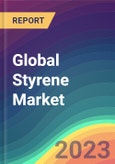The global Styrene market stood at approximately 30 million tonnes in 2021 and is expected to grow at a CAGR of 5.64% during the forecast period until 2030. Recently, a joint venture between LyondellBasell and the China Petroleum & Chemical Corporation (Sinopec) has been formed to produce propylene oxide and styrene monomer for the local Chinese market. This new facility will be able to produce 275 thousand tonnes of tons of propylene oxide and 600 thousand tonnes of styrene monomer each year.The Global Styrene Market Stood at Approximately 30 Million Tonnes in 2021 and is Expected to Grow at a CAGR of 5.64% During the Forecast Period Until 2030
Styrene is a colorless to pale yellowish (after aging) in color and is highly volatile, flammable oily liquid with a sweet smell. Commercially, the majority of the Styrene is produced by the alkylation of Benzene with Ethylene. Ethylbenzene is formed as an intermediate which is further dehydrogenated to form Styrene. Another method for its production is via Ethylbenzene Hyperoxide, in which Styrene is produced as a coproduct by reacting Propylene Oxide (PO) within POSM (Propylene Oxide/Styrene Monomer) units. Mainly there are three technologies to produce Styrene which are EB/PO Technology, Versalis XSBR Technology, and EBMax SM1 Technology. It is primarily used in manufacturing synthetic rubbers, latex, polystyrene resins which are further employed in making disposable cutlery, insulations, pipes, plastic packaging, automobile and electronics part, printing cartridges, containers, etc.
The primary market driver of the global Styrene market industry is the Packaging industry. Due to the exceptional properties of Styrene, it can be utilized to make durable and lightweight products. Growing requirement of packaging material for milk, vegetables, food, meat, and electronic goods, along with requirements for storage purposes is anticipated to augment the growth of the global Styrene market in the forecast period. Other important applications of Styrene in automotive sector for manufacturing components will most likely further drive the Styrene market in coming years. The global Styrene market is anticipated to reach approximately 50 million tonnes by 2030.
Based on its derivatives, the market is segmented into Polystyrene (PS), Acrylonitrile-Butadiene-Styrene (ABS), Unsaturated Polyester Resins (UPR), Styrene-Butadiene Rubber (SBR) and Others. PS is one of the most commonly used thermoplastic resins, which is further classified into types such as High Impact Polystyrene (HIPS), General Purpose Polystyrene (GPPS), Expandable Polystyrene (EPS) and Extruded Polystyrene (XPS). Surging demand for PS from the packaging industry is likely to drive the demand in the forthcoming years. Styrene and its derivatives find applications in various end-use industries such as Automobile, Packaging, Construction, Consumer Goods, and Others. Thereby, growth in these end-user industries is anticipated to boost the market over the forecast period. However, the health and environmental hazards associated with the chemical compound may hamper its market growth in the forecast period.
Asia Pacific is the dominating all over the world with the highest demand of Styrene. This region accounted a market share of about 50% of the global Styrene market in 2021. Due to rapid industrialization, urbanization, ongoing construction projects in the region, market is expected to boost through 2030. Europe stands as the second largest consumer of Styrene. Moreover, China is a manufacturing hub of Consumer Goods, Electronics, and Plastics which is also likely to drive the market for Styrene over the forecast period.
Based on the end-user industry, the Styrene market is segmented into sectors such as Packaging, Automotive Components, Construction Industry, Consumer Goods, and Others. Among these, Packaging industry is leading segment and accounted around 35% of the share of total Styrene demand in 2021. Automotive Components and Construction Industry also hold recognizable market shares.
Significant companies for Global Styrene market are Hanhwa- Total JV, Shell Global, SIBUR, Fermosa Chemical & Fibre Corporation, LyondellBasell, PJSC Lukoil Oil Company, SADAF (Petrokemia), Zhejiang Petrochemical, Trinseo, INEOS Styrolution, Changzhou New Solar Chem, and Samsung Total Petrochemical.
Years considered for this report:
- Historical Period: 2015- 2021
- Base Year: 2021
- Estimated Year: 2022
- Forecast Period: 2023-2030
The objective of the Study:
- To assess the demand-supply scenario of Styrene, which covers the production, demand, and supply of Styrene around the globe.
- To analyze and forecast the market size of Styrene.
- To classify and forecast the Global Styrene market based on end-use and regional distribution.
- To examine global competitive developments such as new capacity expansions, mergers & acquisitions, etc., of the Styrene market.
The publisher calculated Styrene demand in the globe by analyzing the historical data and demand forecast which was carried out considering the historical extraction and supply and demand of Styrene across the globe. The publisher sourced these values from industry experts, and company representatives and externally validated through analyzing historical sales data of respective manufacturers to arrive at the overall market size. Various secondary sources such as company websites, association reports, annual reports, etc., were also studied by the publisher.
Key Target Audience:
- Styrene manufacturers and other stakeholders
- Organizations, forums and alliances related to Styrene distribution
- Government bodies such as regulating authorities and policy makers
- Market research organizations and consulting companies
Report Scope:
In this report, Global Styrene market has been segmented into following categories, in addition to the industry trends which have also been detailed below:- Market, by End-use: Packaging, Automotive Components, Construction Industry, Consumer Goods, and Others
- Market, by Sales Channel: Direct Sale and Indirect Sale
- Market, by Region: North America, Europe, Asia Pacific, Middle East and Africa, and South America.








